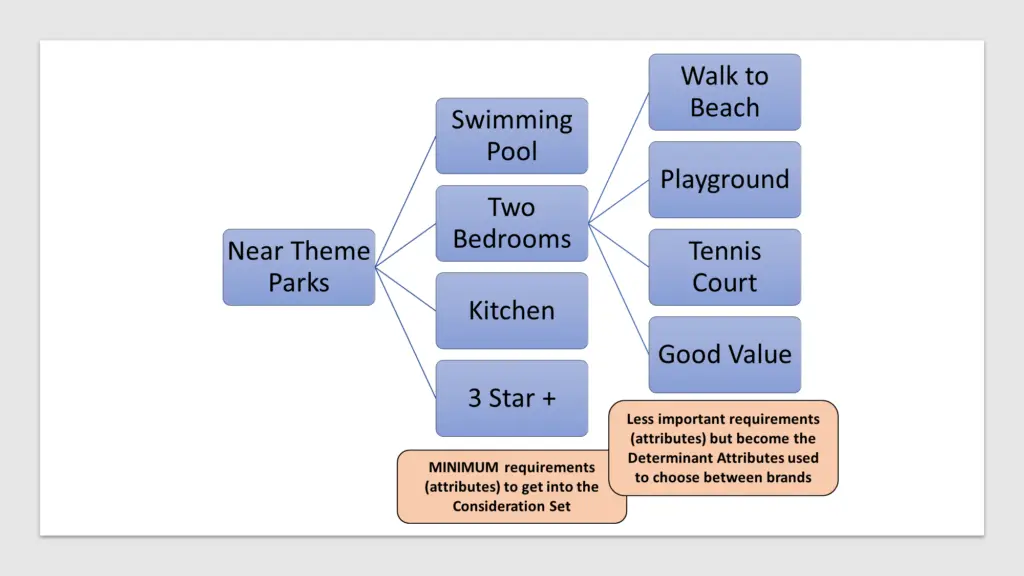Contents
Understanding Determinate Attributes
Determinate attributes are very important when preparing perceptual maps. In particular, the standard two-axis, four-quadrant, perceptual map relies upon determinate attributes being identified and scored and input into the map.
Important: Products are the Sum of their Attributes
All products are made up of individual attributes, which are essentially all their products features and benefits.
For example, a table and chair set would be made up of different pieces of material, different colors, different shapes, different sizes and so on.
All these are individual product attributes help deliver benefits to the consumer, such as convenience, comfort, style, household decorations, durability, and so on
This means that attributes are a combination of:
- product features,
- product benefits,
- characteristics of the product, and
- characteristics of the brand
For a great list of potential brand and product attribute ideas for your perceptual maps, check out: List of Axis Attribute Ideas for Perceptual Maps
But what are determinant attributes? Please review the video or scroll down for the full article.
Two Main Types of Attributes
There are two types of product attributes that marketers need to be aware of, namely:
- Important attributes and
- Determinate attributes.
Important attributes are the features/benefits a product MUST possess for a consumers to consider it a possible suitable choice to their purchase decision.
A consumer will then consider multiple alternatives of brands that possess all their important attributes, then the consumer will select the most appropriate brand based on the brand’s determinate attributes.
To make sense of the difference, let’s quickly review the first part of the buyer decision process that you’ve probably seen before. These are the steps that a buyer goes through in making a purchase decision…
1. To start the process, there is a need (or problem) recognition
This means that the consumer has a problem with their life, or they’ve run out of something, or they feel that they need something, and then they go:
- “I need to buy something.”
This recognition is the starting point of the buyer decision process.
2. If it’s a higher involvement type purchase, they gather information, known as “information search” in the process
The consumer gathers relevant information to help them choose. They may jump online, they may look at ads, they may look at products in the store, or even talk to family and friends.
3. Evaluation of Potential Alternatives
After information search, the consumer will have a short list of possibilities, and then they go:
- “Okay, which one do I want? Which is the better choice?”
If you’re buying a car, for example, you’ll look at multiple cars and construct an approach to choose between the brands.
It’s in this stage where perceptual maps come into play and determinant attributes become quite important.
Determinant attributes are the deciding attributes – the ones that consumers use to move from the evaluation to choice.
An Example of Determinate Attributes
Probably the best way to understand the difference between an important attribute and the determinate attributes is to use an example. This example is listed in the diagram to the left, for a family holiday decision.

As you can see there are two sets of attributes listed, the first of all boxed under important attributes, and the second all boxed around determinate attributes.
This family who is looking to book a holiday has important attributes of the hotel being located near a theme park, having a two-bedroom suite available, a kitchen available, a swimming pool, and the of a reasonable quality standard there would probably be a number of hotels that would satisfy these important attributes for the family.
Therefore, to complete a decision, the decision maker then relies upon determinate attributes.
In this case, the determinate attributes that will decide the final choice of hotel for the family are:
- its location relative to the beach,
- whether or not it has a children’s program,
- whether or not it has tennis courts, and
- whether or not it provides good value.
More Examples of Determinant Attributes
In the following three examples of airline advertising, you can see that the airline is not advertising or promoting its core service.
In the case of an airline, its core service would be flying people to certain destinations. Instead each airline focuses on what they perceive to be the consumer’s determinate attribute – or how they are choosing between airlines.
In the first ad, United Airlines sees seat space and legroom as a determinate attribute. Then Southwest sees the ability to use a laptop and a cellphone during the flight as a determinate attribute. And finally, Air New Zealand sees quality food as being a determinate attribute.
In other words, these are the aspects of the service offering that the airlines believe that consumers use to help differentiate and choose between competing brands. Therefore, it should be these types of attributes that are listed on perceptual maps.
Points of Parity and Points of Difference
To help clarify the above airlines examples, let’s talk about points of parity and points of difference.
Points of parity are the attributes that all airlines share, such as the ability to take you to your destination and the price range.
Points of difference are the attributes that make an airline stand out from its competitors, such as the quality of food and the likelihood of delays.
But which ones are the determinant attributes, which are the factors that determine your choice of airline.
These attributes vary from person to person, but some common ones include comfortable seating, suitable travel times, and the likelihood of delays.
Video overview explaining Points of Parity and Points of Difference…
How Determinant Attributes Connect to Perceptual Maps
When we look at perceptual maps, we often focus on the wrong things. We tend to look at points of parity because they are what we expect from all airlines.
However, once an airline has met these expectations, it is the points of difference that matter. These are the attributes that will make a consumer choose one airline over another.
So once we see that the airlines being consider meet your most important attributes, then we drill down and then looking for less important attributes in order to identify points of difference that matter to you.
For example, if good food is a priority, look for airlines that offer quality meals. If you’re concerned about delays, look for airlines with a good track record for timeliness.
Quick FAQs for Determinant Attributes
What are determinate attributes?
Determinate attributes are the specific attributes or characteristics of a product that consumers consider when making a choice between competing brands. They are the deciding factors that help consumers move from the evaluation stage to the final choice.
How do determinate attributes differ from important attributes?
Important attributes are the features or benefits a product must possess for consumers to consider it a suitable choice. Determinate attributes, on the other hand, are the attributes that consumers use to differentiate and choose between competing brands after considering the important attributes.
How do determinate attributes connect to perceptual maps?
Determinate attributes are important in perceptual maps because they help identify the points of difference between competing brands. Once consumers have identified brands that meet their important attributes, they look for less important attributes to find the points of difference that matter to them.
Can you provide an example of determinant attributes in decision-making?
Let’s consider a family deciding on a holiday destination. The important attributes for the family may include a hotel near a theme park, a two-bedroom suite, a kitchen, and a swimming pool.
The determinate attributes, which will decide the final choice, could be the hotel’s location relative to the beach, the availability of a children’s program, the presence of tennis courts, and the value offered.
How do determinant attributes relate to points of parity and points of difference?
Points of parity are attributes shared by all brands within a category, such as the ability to take passengers to their destinations.
Points of difference are attributes that set one brand apart from its competitors, such as the quality of food or the likelihood of delays.
Determinant attributes are the factors that consumers consider when determining their choice between competing brands, which can include both points of parity and points of difference.
Why are determinant attributes important in marketing?
Determinant attributes are important in marketing because they help marketers understand what attributes consumers prioritize when making purchasing decisions. By identifying and focusing on these attributes, marketers can better position their products or brands to meet consumer needs and preferences.
How are determinant attributes identified?
Determinant attributes are identified through consumer research and analysis. Marketers can conduct surveys, interviews, observation, or focus groups to gather data on consumer preferences and determine which attributes play a crucial role in the decision-making process.
Are determinant attributes the same for all consumers?
Determinant attributes are likely to vary from person to person based on individual preferences and priorities. While some attributes may be commonly considered determinant by many consumers, others may be more specific to certain segments or individuals.
Related Helpful Information
- List of Axis Attribute Ideas for Perceptual Maps
- How to Choose Attributes for a Perceptual Map
- How to Analyze Perceptual Maps
- Take me to the download page: Free Download of the Perceptual Map Template



